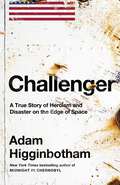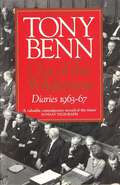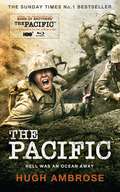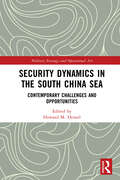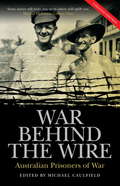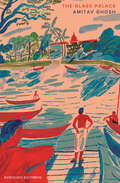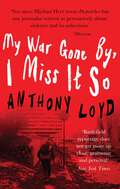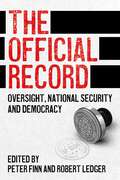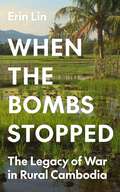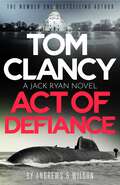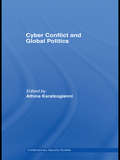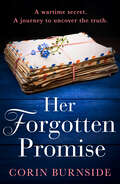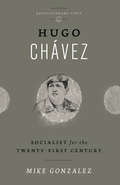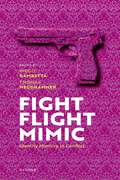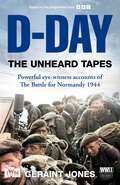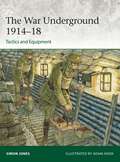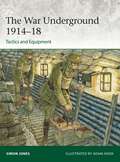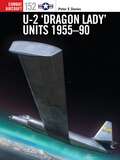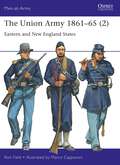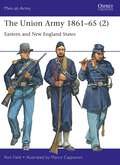- Table View
- List View
Challenger: A True Story of Heroism and Disaster on the Edge of Space
by Adam HigginbothamFrom the New York Times-bestselling author of Midnight in Chernobyl comes the definitive, dramatic, minute-by-minute story of the Challenger space shuttle disaster based on fascinating in-depth reporting and new archival research – riveting history that reads like a thriller'Gripping' ED CAESAR • 'Masterly' GEOFF DYER • 'Incredible' TIM HARFORDOn the morning of 28 January 1986, just seventy-three seconds into flight, the space shuttle Challenger broke apart over the Atlantic Ocean, killing all seven people on board. Millions around the world witnessed the tragic deaths of the crew, which included schoolteacher Christa McAuliffe. Like the assassination of JFK, the Challenger disaster is a defining moment in twentieth century history – one that forever changed the way America thought of itself and its optimistic view of the future. Yet the full story of what happened – and why – has never been told.Based on extensive archival research and meticulous, original reporting, Challenger: A True Story of Heroism and Disaster on the Edge of Space follows a handful of central protagonists – including each of the seven members of the doomed crew – through the years leading up to the accident, a detailed account of the tragedy itself, and into the investigation that followed. It’s a compelling tale of optimism and ingenuity shattered by political cynicism and cost-cutting in the interests of burnishing national prestige; of hubristic ‘go fever’; and of an investigation driven by heroic leakers and whistle-blowers determined to bring the truth to light.With astonishing clarity and narrative verve, Adam Higginbotham reveals the history of the shuttle program, the lives of men and women whose stories have been overshadowed by the disaster, as well as the designers, engineers and test pilots who struggled against the odds to get the first shuttle into space. A masterful blend of riveting human drama, fascinating science and shocking political infighting, Challenger brings to life a turning point in our history. The result is an even more complex and extraordinary story than any of us remembered – or thought possible.
Out Of The Wilderness: Diaries 1963-67
by Tony Benn1963 saw Labour's emergence from its 'wilderness years' in Opposition, and the election of Harold Wilson following the unexpected death of Hugh Gaitskell. In the first Wilson government of 1964 Benn was made Postmaster General and became known as an innovator for his introduction of the Giro and arguing for a radical broadcasting policy. After Labour's landslide victory of 1966 he was appointed to the Cabinet as Minister of Technology, but Labour's honeymoon came to an abrupt end in 1967 with the introduction of devaluation, leading to disilliusionment with the Government.Tony Benn's account on his relations with the industrialists, television and press chiefs, the Palace and the diplomatic world as well as trade unionists, civil servants, and his Cabinet colleagues, reveals the workings of our political and economic systems at the highest level.Out of the Wilderness is a unique political record of the 1960s, told by a man who served in five Labour administrations and who today is one of the most experienced figures both in and out of the House of Commons.'No-one interested in the political influence of the Crown, the intrigues of the civil service or the highly traditionalist character of Harold Wilson can afford to ignore it' The Observer
The Pacific (The Official HBO/Sky TV Tie-In): Hell Was An Ocean Away
by Hugh AmbroseSidney C. Philips, an easygoing Alabama teenager, enlisted along with a friend. 'Manila John' Basilone was the son of immigrants who found happiness in the rough-and-ready life of a marine. Eugene B. Sledge watched his best friend and brother go off to war - and finally rebelled against his parents to follow them. 'Shifty' Shofner was the scion of a prominent family with a long record of military service. Ensign Vernon 'Mike' Micheel left the family farm to complete flight school. Between America's retreat from China in late 1941 and the moment that MacArthur's plane landed in Japan in August 1945, these five men fought many of the key battles of the war in the Pacific. Here, Hugh Ambrose focuses on their real-life experiences and those of their fellow servicemen, enhancing and expanding upon the story told in the HBO miniseries. Covering nearly four years of combat with unprecedented access to military records, letters, journals, memoirs, photographs and interviews, this volume offers a unique historical perspective on the war against Japan, from the debacle in Bataan to the miracle of Midway, the relentless vortex of Guadalcanal, the black terraces of Iwo Jima and the killing fields of Okinawa - and ultimately the triumphant yet uneasy return home. These are the true stories of the men who put their lives on the line for their country, who were dispatched to the other side of the world to fight an enemy who preferred suicide to surrender; men who suffered hardship and humiliation in POW camps; men who witnessed casualties among soldiers and civilians alike; and men whose medals came at a shocking price - a price paid in full by all.
Security Dynamics in the South China Sea: Contemporary Challenges and Opportunities (Military Strategy and Operational Art)
This volume examines the South China Sea’s regional security dynamics, highlighting the challenges and opportunities for both littoral and non-littoral states.The South China Sea is a vital pathway for the great container ships and tankers, as well as for the naval vessels of today. Indeed, the security of the contemporary global economy is reliant more than ever upon the dependability of freedom of navigation through the waters of the South China Sea. This volume concentrates on the security of the South China Sea sub-region. It is designed to help illuminate the contemporary security dynamics within this important sub-region by highlighting its development, the contemporary challenges and opportunities confronting both the littoral states and the non-littoral powers that are active in the sub-region, and the policy responses of those states as they seek to defend and promote their national interests. This book is composed of 16 chapters and is organized into five thematic sections. Part I of the book is designed to set the historical context. Part II examines some of the contemporary challenges and opportunities that present themselves in the sub-region, while Part III focuses on Chinese policy in the South China Sea sub-region. Parts IV and Part V analyse and evaluate the contemporary policies of the various littoral and non-littoral powers that are active in the South China Sea sub-region. The collective analyses and assessments of the contemporary perceptions and policies of the various littoral and non-littoral powers active in the South China Sea in response to the traditional and non-traditional challenges within the sub-region that are examined in the chapters contained in Parts III, IV, and V, framed against the material presented in Parts I and II, provides the basis for observations concerning areas of conflicting and coinciding interests in the concluding chapter of the book.This book will be of interest to students of the South China Sea, maritime security, Asian politics, and international relations.
Security Dynamics in the South China Sea: Contemporary Challenges and Opportunities (Military Strategy and Operational Art)
by Howard M. HenselThis volume examines the South China Sea’s regional security dynamics, highlighting the challenges and opportunities for both littoral and non-littoral states.The South China Sea is a vital pathway for the great container ships and tankers, as well as for the naval vessels of today. Indeed, the security of the contemporary global economy is reliant more than ever upon the dependability of freedom of navigation through the waters of the South China Sea. This volume concentrates on the security of the South China Sea sub-region. It is designed to help illuminate the contemporary security dynamics within this important sub-region by highlighting its development, the contemporary challenges and opportunities confronting both the littoral states and the non-littoral powers that are active in the sub-region, and the policy responses of those states as they seek to defend and promote their national interests. This book is composed of 16 chapters and is organized into five thematic sections. Part I of the book is designed to set the historical context. Part II examines some of the contemporary challenges and opportunities that present themselves in the sub-region, while Part III focuses on Chinese policy in the South China Sea sub-region. Parts IV and Part V analyse and evaluate the contemporary policies of the various littoral and non-littoral powers that are active in the South China Sea sub-region. The collective analyses and assessments of the contemporary perceptions and policies of the various littoral and non-littoral powers active in the South China Sea in response to the traditional and non-traditional challenges within the sub-region that are examined in the chapters contained in Parts III, IV, and V, framed against the material presented in Parts I and II, provides the basis for observations concerning areas of conflicting and coinciding interests in the concluding chapter of the book.This book will be of interest to students of the South China Sea, maritime security, Asian politics, and international relations.
War Behind the Wire: Australian Prisoners of War
by Michael CaulfieldMichael Caulfield presents accounts of Australian prisoners of war, capturing the Aussie spirit that manages to endure through all.
The Glass Palace
by null Amitav GhoshThe International Bestseller from the Man Booker Prize shortlisted author 'An absorbing story of a world in transition’ JM Coetzee 'A Doctor Zhivago for the Far East' The Independent Rajkumar is only another boy, helping on a market stall in the dusty square outside the royal palace, when the British force the Burmese King, Queen and all the Court into exile. He is rescued by the far-seeing Chinese merchant, and with him builds up a logging business in upper Burma. But haunted by his vision of the Royal Family, he journeys to the obscure town in India where they have been exiled. The story follows the fortunes – rubber estates in Malaya, businesses in Singapore, estates in Burma – which Rajkumar, with his Chinese, British and Burmese relations, friends and associates, builds up – from 1870 through the Second World War to the scattering of the extended family to New York and Thailand, London and Hong Kong in the post-war years.
My War Gone By, I Miss It So
by Anthony Loyd'Undoubtedly the most powerful and immediate book to emerge from the Balkan horror of ethnic civil war' Antony Beevor, Daily TelegraphIn 1993, Anthony Loyd hitchhiked to the Balkans hoping to become a journalist. Leaving behind him the legends of a distinguished military family, he wanted to see 'a real war' for himself. In Bosnia he found one. The cruelty and chaos of the conflict both appalled and embraced him; the adrenalin lure of the action perhaps the loudest siren call of all. In the midst of the daily life-and-death struggle among Bosnia's Serbs, Croats and Muslims, Loyd was inspired by the extraordinary human fortitude he discovered. But returning home he found the void of peacetime too painful to bear, and so began a longstanding personal battle with drug abuse. This harrowing account shows humanity at its worst and best. It is a breathtaking feat of reportage; an uncompromising look at the terrifyingly seductive power of war. 'As good as reporting gets. I have nowhere read a more vivid account of frontline fear and survival. Forget the strategic overview. All war is local' Martin Bell, The Times
The Official Record: Oversight, national security and democracy
by Peter Finn Robert LedgerThe construction, control and preservation of the Official Record is inherently contested. Those seeking greater openness and (democratic) accountability argue 'sunlight is [...] the best of disinfectants’, while others seek stricter information control because, to their mind, sound government arises when advice and policy are formulated secretly. This edited volume explores the intersection of the Official Record, oversight, national security and democracy. Through US, UK and Canadian case studies, this volume will benefit higher level undergraduate readers and above to explore the Official Record in the context of the national security operations of democratic states. All chapters are research-based pieces of original writing that feature a document appendix containing primary documents (often excerpts) that are key to a chapter’s narrative. As a result, this book interrogates the boundaries between national security, accountability, oversight, and the Official Record.
The Official Record: Oversight, national security and democracy
by Peter Finn Robert LedgerThe construction, control and preservation of the Official Record is inherently contested. Those seeking greater openness and (democratic) accountability argue 'sunlight is [...] the best of disinfectants’, while others seek stricter information control because, to their mind, sound government arises when advice and policy are formulated secretly. This edited volume explores the intersection of the Official Record, oversight, national security and democracy. Through US, UK and Canadian case studies, this volume will benefit higher level undergraduate readers and above to explore the Official Record in the context of the national security operations of democratic states. All chapters are research-based pieces of original writing that feature a document appendix containing primary documents (often excerpts) that are key to a chapter’s narrative. As a result, this book interrogates the boundaries between national security, accountability, oversight, and the Official Record.
When the Bombs Stopped: The Legacy of War in Rural Cambodia (Princeton Studies in International History and Politics #206)
by Erin LinHow undetonated bombs from a war that ended more than fifty years ago still affect Cambodian farmers and their land Over the course of the Vietnam War, the United States dropped 500,000 tons of bombs over Cambodia—more than the combined weight of every man, woman, and child in the country. What began as a secret CIA infiltration of Laos eventually expanded into Cambodia and escalated into a nine-year war over the Ho Chi Minh trail fought primarily with bombs. Fifty years after the last sortie, residents of rural Cambodia are still coping with the unexploded ordnance that covers their land. In When the Bombs Stopped, Erin Lin investigates the consequences of the US bombing campaign across postconflict Cambodia.Drawing on interviews, original econometric analysis, and extensive fieldwork, Lin upends the usual scholarly perspective on the war and its aftermath, presenting the viewpoint of those who suffered the bombing rather than those who dropped the bombs. She shows that Cambodian farmers stay at a subsistence level because much of their land is too dangerous to cultivate—and yet, paradoxically, the same bombs that endanger and impoverish farming communities also protect them, deterring predatory elites from grabbing and commodifying their land. Lin argues that the half-century legacy of American bombs has sedimented the war into the layers of contemporary Cambodian society. Policies aimed at developing or modernizing Cambodia, whether economic liberalization or authoritarian consolidation, must be realized in an environment haunted by the violence of the past. As the stories Lin captures show, the bombing served as a critical juncture in these farming villages, marking the place in time where development stopped.
When the Bombs Stopped: The Legacy of War in Rural Cambodia (Princeton Studies in International History and Politics #206)
by Erin LinHow undetonated bombs from a war that ended more than fifty years ago still affect Cambodian farmers and their land Over the course of the Vietnam War, the United States dropped 500,000 tons of bombs over Cambodia—more than the combined weight of every man, woman, and child in the country. What began as a secret CIA infiltration of Laos eventually expanded into Cambodia and escalated into a nine-year war over the Ho Chi Minh trail fought primarily with bombs. Fifty years after the last sortie, residents of rural Cambodia are still coping with the unexploded ordnance that covers their land. In When the Bombs Stopped, Erin Lin investigates the consequences of the US bombing campaign across postconflict Cambodia.Drawing on interviews, original econometric analysis, and extensive fieldwork, Lin upends the usual scholarly perspective on the war and its aftermath, presenting the viewpoint of those who suffered the bombing rather than those who dropped the bombs. She shows that Cambodian farmers stay at a subsistence level because much of their land is too dangerous to cultivate—and yet, paradoxically, the same bombs that endanger and impoverish farming communities also protect them, deterring predatory elites from grabbing and commodifying their land. Lin argues that the half-century legacy of American bombs has sedimented the war into the layers of contemporary Cambodian society. Policies aimed at developing or modernizing Cambodia, whether economic liberalization or authoritarian consolidation, must be realized in an environment haunted by the violence of the past. As the stories Lin captures show, the bombing served as a critical juncture in these farming villages, marking the place in time where development stopped.
Tom Clancy Act of Defiance: The unmissable gasp-a-page Jack Ryan thriller (Jack Ryan #24)
by Jeffrey Wilson Brian AndrewsFOR JACK RYAN, THE GREATEST THREAT LURKS BENEATH THE WAVES . . . AGAIN When a Russian superweapon is let loose under the waves, it's up to President Jack Ryan to find a countermove in the latest entry in this #1 New York Times bestselling series.US intelligence is reporting turmoil in the Russian navy. Their deadliest submarine, the Belgorod, has unexpectedly launched. Who authorised the departure? What mission is it on? And, most disturbing of all, what weapons do the giant doors on the sub's bow hide?It's been four decades since a similar incident with the Soviet sub, Red October, ended happily, thanks to a young CIA analyst named Jack Ryan.Now, President Jack Ryan finds himself with fleets of ships, squadrons of jets, and teams of SEALs at his command, but what he doesn't have is insight into the plans of the Belgorod's commander. It falls to a younger generation of Ryans to do the dangerous work that will reveal that information.But there's always a price to be paid. When the final moments tick away, will Jack Ryan have to choose between the safety of his country and the safety of his child?___________PRAISE FOR TOM CLANCY'Constantly taps the current world situation for its imminent dangers and spins them into an engrossing tale'NEW YORK TIMES'Exhilarating. No other novelist is giving so full a picture of modern conflict'SUNDAY TIMES'A brilliantly constructed thriller that packs a punch'DAILY MAIL'Heart-stopping action . . . entertaining and eminently topical'WASHINGTON POST
Cyber-Conflict and Global Politics (Contemporary Security Studies)
by Athina KaratzogianniThis volume examines theoretical and empirical issues relating to cyberconflict and its implications for global security and politics. Taking a multidimensional approach to current debates in internet politics, the book comprises essays by leading experts from across the world. The volume includes a comprehensive introduction to current debates in the field and their ramifications for global politics, and follows this with empirical case studies. These include cyberconflict, cyberwars, information warfare and hacktivism, in contexts such as Sri Lanka, Lebanon and Estonia, the European Social Forum, feminist cybercrusades and the use of the internet as a weapon by ethnoreligious and socio-political movements. The volume presents the theoretical debates and case studies of cyberconflict in a coherent, progressive and truly multidisciplinary way. The book will be of interest to students of cyberconflict, internet politics, security studies and IR in general.
Cyber-Conflict and Global Politics (Contemporary Security Studies)
by Athina KaratzogianniThis volume examines theoretical and empirical issues relating to cyberconflict and its implications for global security and politics. Taking a multidimensional approach to current debates in internet politics, the book comprises essays by leading experts from across the world. The volume includes a comprehensive introduction to current debates in the field and their ramifications for global politics, and follows this with empirical case studies. These include cyberconflict, cyberwars, information warfare and hacktivism, in contexts such as Sri Lanka, Lebanon and Estonia, the European Social Forum, feminist cybercrusades and the use of the internet as a weapon by ethnoreligious and socio-political movements. The volume presents the theoretical debates and case studies of cyberconflict in a coherent, progressive and truly multidisciplinary way. The book will be of interest to students of cyberconflict, internet politics, security studies and IR in general.
Her Forgotten Promise
by Corin Burnside‘A story of love, loss, sacrifice and bravery. After this stunning debut, I can't wait to see what Corin writes next!’ Kathleen McGurl, author of The Girl from Bletchley Park A wartime secret. A journey to uncover the truth.
Hugo Chavez: Socialist for the Twenty-first Century (Revolutionary Lives)
by Mike GonzalezWhen Hugo Chavez, then President of Venezuela, died in 2013, millions across the globe mourned. In an age where most politicians inspire only apathy and cynicism, Chavez's popularity, radicalism and vibrant personality were truly unique. Released one year after Chavez's unexpected death, this dramatic and intimate biography traces Chavez's life from an impoverished rural family to the Miraflores Presidential Palace in Caracas. Mike Gonzalez shows how Chavez's 'Bolivarian revolution' aimed to complete Simon Bolivar's promise of a Latin America free from imperialism. Gonzalez details Chavez's close connection to the masses and how he enraged wealthy elites by declaring his support for 21st century socialism. He concludes that the struggle for social justice inspired by Chavez can and must continue. This is an ideal guide to Chavez's inspiring life and legacy.
Fight, Flight, Mimic: Identity Mimicry in Conflict
FIight, Flight, Mimic is the first systematic study of deceptive mimicry in the context of wars. Deceptive mimicry -- the manipulation of individual or group identity -- includes passing off as a different individual, as a member of a group to which one does not belong, or, for a group, to 'sign' its action as another group. Mimicry exploits the reputation of the model it mimics to avoid capture (flight), to strike undetected at the enemy (fight), or to hide behind or besmirch the reputation of the model group ('false flag' operations). These tactics have previously been described anecdotally, mixed in with other ruses de guerre, but the authors show that mimicry is a distinct form of deception with its own logic and particularly consequential effects on those involved. The book offers a theory and game-theoretic model of mimicry, an overview of its use through history, and a deep empirical exploration of its modern manifestations through several case studies by leading social scientists. The chapters cover mimicry in the context of the Northern Ireland conflict, terrorism campaigns in 1970s Italy, the height of the Iraq insurgency, the Rwandan genocide, the Naxalite rebellion in India, and jihadi discussion forums on the Internet.
D-Day: Powerful Eye-witness Accounts of The Battle for Normandy 1944
by Geraint JonesA powerful, immersive account published for the 80th anniversary of the D-Day landings and battle for Normandy, accompanying a groundbreaking BBC2 documentary series D-Day: The Unheard Tapes.D-Day was a critical turning point in the Second World War, and a master stroke in planning and logistics, but for the tens of thousands of young men who took part in the amphibious assault, D-Day was bloody, chaotic, and frequently terrifying. For those who survived the beaches, months of bitter fighting lay ahead, often against some of Germany's most elite and fanatical divisions.Using audio interviews from the archives of the Imperial War Museums and National World War II Museum, this immersive oral history describes what it was actually like to take part in the landings on 6 June 1944 and the weeks of ferocious fighting in Normandy that followed. British, American, Canadian and German veterans, as well as French civilians, speak of experiences they could never forget.Stories include the forward observer hiding alone on Omaha beach, thinking of his wife as he waits for the invasion to begin. The commando racing to the besieged airborne forces at Pegasus Bridge. The Typhoon pilot about to be executed by the SS when he is saved by a Luftwaffe officer. The teenage GI surrounded and under fire for six days. The German soldier haunted by the memory of abandoning his dying friend.In D-Day The Unheard Tapes Geraint Jones has skilfully brought the battle for Normandy to life in a vivid narrative that allows the voices of those who fought to shine through, authentic and unforgettable.
The War Underground 1914–18: Tactics and Equipment (Elite #256)
by Simon JonesThis absorbing illustrated study reveals the evolving tactics and techniques used by all sides in the underground war during 1914–18. Covering the Western Front but also the Gallipoli and Italian theatres, this study explores three aspects of World War I below ground: military mining, attack tunnels and dugouts. In 1914–17, the underground war was a product of static trench warfare, essential to survive it and part of both sides' attempts to overcome it. In 1917–18 it was rendered largely obsolete by the development of the all-arms battle as mobility was restored to the battlefield. In the stagnant, troglodyte existence of trench warfare, military mining was a hidden world of heroism and terror in which hours of suspenseful listening were spent monitoring the steady picking of unseen opponents, edging quietly towards the enemy, and judging when to fire a charge. Break-ins to enemy mine galleries resulted in hand-to-hand fighting in the darkness. The ingenuity, claustrophobia and tactical importance of the underground war are discussed and depicted in this fully illustrated study from an acknowledged expert. The artwork plates include depictions of the specialized uniforms, weapons and equipment used underground, as well as vignettes that vividly convey the many aspects of subterranean warfare during World War I.
The War Underground 1914–18: Tactics and Equipment (Elite #256)
by Simon JonesThis absorbing illustrated study reveals the evolving tactics and techniques used by all sides in the underground war during 1914–18. Covering the Western Front but also the Gallipoli and Italian theatres, this study explores three aspects of World War I below ground: military mining, attack tunnels and dugouts. In 1914–17, the underground war was a product of static trench warfare, essential to survive it and part of both sides' attempts to overcome it. In 1917–18 it was rendered largely obsolete by the development of the all-arms battle as mobility was restored to the battlefield. In the stagnant, troglodyte existence of trench warfare, military mining was a hidden world of heroism and terror in which hours of suspenseful listening were spent monitoring the steady picking of unseen opponents, edging quietly towards the enemy, and judging when to fire a charge. Break-ins to enemy mine galleries resulted in hand-to-hand fighting in the darkness. The ingenuity, claustrophobia and tactical importance of the underground war are discussed and depicted in this fully illustrated study from an acknowledged expert. The artwork plates include depictions of the specialized uniforms, weapons and equipment used underground, as well as vignettes that vividly convey the many aspects of subterranean warfare during World War I.
U-2 ‘Dragon Lady’ Units 1955–90 (Combat Aircraft #152)
by Peter E. DaviesAn illustrated account of the early service of the Lockheed U-2, one of the most important and longest-serving intelligence gathering platforms fielded by the US air force.The U-2 is one of the most recognizable aircraft of the Cold War; nicknamed the 'Dragon Lady' after the codename given to it by the CIA, this powered glider was designed and operated in great secrecy, providing US authorities with photographic and electronic information from areas of interest across the globe. This illuminating new volume dives deep into the U-2's most critical missions, exploring its role in the Cuban Missile Crisis, nuclear reconnaissance in the Soviet Union, and intelligence missions in China and North Vietnam.Using previously unpublished research, aviation expert Peter E. Davies examines the operations of one of the landmark aircraft of the 20th century from a fresh and engaging perspective, enhanced by more than 50 photos and 21 newly commissioned profile artworks.
U-2 ‘Dragon Lady’ Units 1955–90 (Combat Aircraft #152)
by Peter E. DaviesAn illustrated account of the early service of the Lockheed U-2, one of the most important and longest-serving intelligence gathering platforms fielded by the US air force.The U-2 is one of the most recognizable aircraft of the Cold War; nicknamed the 'Dragon Lady' after the codename given to it by the CIA, this powered glider was designed and operated in great secrecy, providing US authorities with photographic and electronic information from areas of interest across the globe. This illuminating new volume dives deep into the U-2's most critical missions, exploring its role in the Cuban Missile Crisis, nuclear reconnaissance in the Soviet Union, and intelligence missions in China and North Vietnam.Using previously unpublished research, aviation expert Peter E. Davies examines the operations of one of the landmark aircraft of the 20th century from a fresh and engaging perspective, enhanced by more than 50 photos and 21 newly commissioned profile artworks.
The Union Army 1861–65: Eastern and New England States (Men-at-Arms #555)
by Ron FieldThis book describes and illustrates the uniforms and personal equipment of the troops fielded by the Eastern and New England states that fought for the Union during the American Civil War. During 1861–65, the United States Army, pitted against the forces of the fledgling Confederacy, fought to defend the Union during five long years of bitter conflict. This volume, the second in a three-part study, chronicles the clothing, insignia and gear worn by the soldiers fielded by 12 of the states that fought to preserve the Union. While uniforms conforming to standard Union Army patterns were widely issued to these troops, some wore distinctive items of dress or insignia, and a wide variety of weapons were carried. Ron Field, an acknowledged authority on US military apparel, reveals how the Eastern and New England states clothed and equipped their regiments during the Civil War. Eight plates of original artwork showing officers and enlisted men of the Union Army are complemented by photographs of soldiers and items of uniform from a variety of sources.
The Union Army 1861–65: Eastern and New England States (Men-at-Arms #555)
by Ron FieldThis book describes and illustrates the uniforms and personal equipment of the troops fielded by the Eastern and New England states that fought for the Union during the American Civil War. During 1861–65, the United States Army, pitted against the forces of the fledgling Confederacy, fought to defend the Union during five long years of bitter conflict. This volume, the second in a three-part study, chronicles the clothing, insignia and gear worn by the soldiers fielded by 12 of the states that fought to preserve the Union. While uniforms conforming to standard Union Army patterns were widely issued to these troops, some wore distinctive items of dress or insignia, and a wide variety of weapons were carried. Ron Field, an acknowledged authority on US military apparel, reveals how the Eastern and New England states clothed and equipped their regiments during the Civil War. Eight plates of original artwork showing officers and enlisted men of the Union Army are complemented by photographs of soldiers and items of uniform from a variety of sources.
